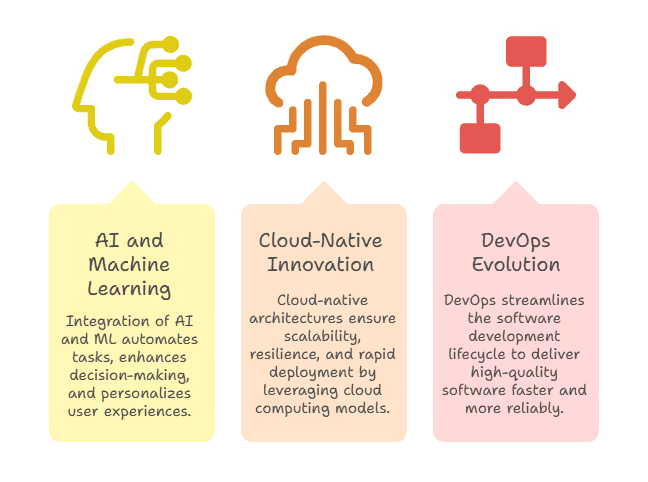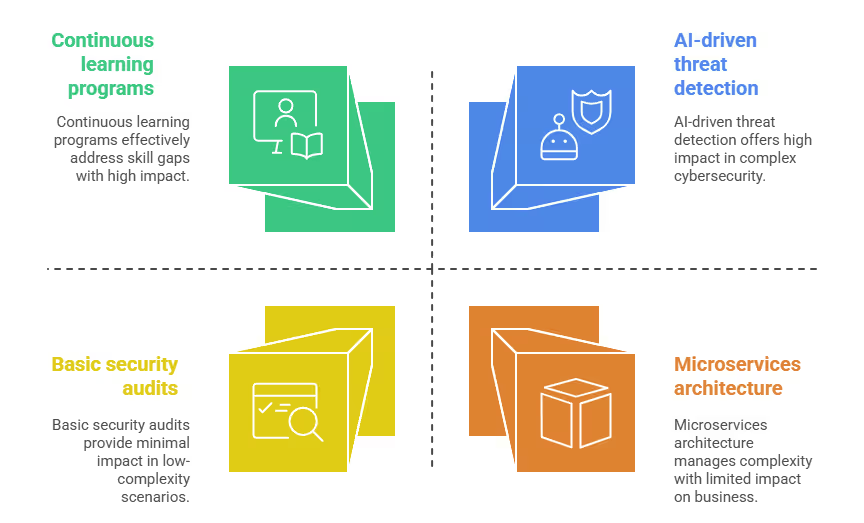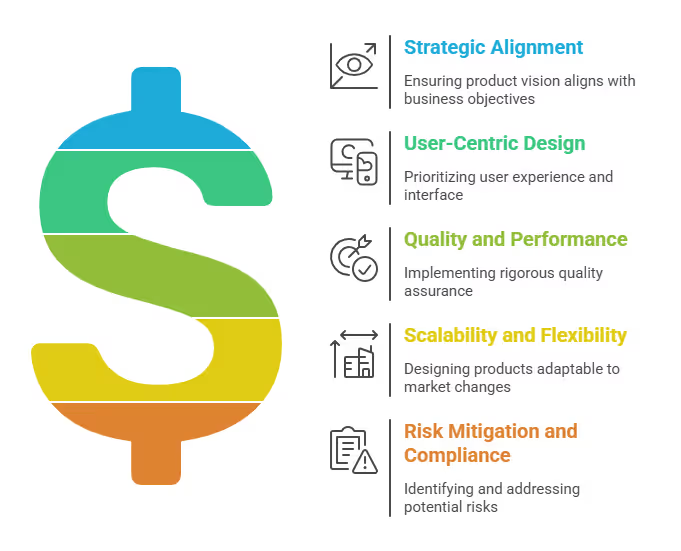Innovation in Software Development: How U.S. Companies Stay Ahead

Innovation in Software Development for US Businesses
In today's dynamic business environment, the pace of innovation in software development in the United States is not just fast; it's a fundamental driver of competitive advantage. Consider this compelling fact: over 93% of US companies are planning to increase their Artificial Intelligence (AI) investments over the next two years, with more than half boosting their AI budgets by over 16%. This isn't a fleeting trend; it's a clear signal of a deep commitment to leveraging technology for growth.
Innovation in software development refers to the adoption of new tools, processes, and technologies, such as AI, DevOps, low-code platforms, and cloud computing, to improve efficiency, speed, and product quality. For U.S. companies, innovation enables faster time-to-market, greater customer satisfaction, and long-term competitive advantage.
As a software development company with over a decade of hands-on experience, having delivered hundreds of complex projects across diverse sectors, from robust web and mobile applications to advanced AI solutions and comprehensive product engineering services, we have a unique vantage point. We've seen firsthand how strategic software innovation transforms challenges into opportunities for businesses across the nation.
The scope of innovation in software development in the US is rapidly expanding, driven by AI, cloud-native solutions, and agile methodologies, reshaping industries and creating new opportunities for businesses to achieve exponential growth.

The Core Drivers of Software Innovation in the US
Innovation doesn't emerge in isolation; it's a direct result of market demands, technological breakthroughs, and a relentless pursuit of efficiency.
In the U.S. market, several powerful forces are converging to redefine what's possible in software development, pushing the boundaries of what applications can achieve.
Artificial Intelligence and Machine Learning: The New Frontier
The integration of Artificial Intelligence (AI) and Machine Learning (ML) stands as the single most impactful software innovation trend in the US. These technologies are no longer theoretical; they are embedded deeply into modern applications, automating tasks, enhancing decision-making, and personalizing user experiences at an unprecedented scale.
- Automated Code Generation: Tools like GitHub Copilot, powered by advanced AI, are revolutionizing how developers write code. They suggest snippets, identify potential bugs, and even generate entire functions, significantly boosting developer productivity. For instance, Bancolombia leveraged GitHub Copilot to achieve a 30% increase in code generation, leading to an average of 18,000 automated application changes annually.
- Intelligent Automation: From automating complex business processes to streamlining internal workflows, AI is enabling software to perform tasks that once required extensive manual intervention. This frees up valuable human talent to focus on higher-value, creative work. EchoStar Hughes division, for example, leveraged Microsoft Azure AI Foundry to create 12 new production apps, projected to save 35,000 work hours and boost productivity by at least 25%.
- Enhanced Quality Assurance: AI-driven tools are transforming bug detection and testing. They can automatically identify, classify, and even suggest fixes for bugs. These systems can also predict errors before they occur, proactively mitigating risks, and execute tests faster and more comprehensively than traditional methods, leading to more reliable and secure software.
Companies like Canva have successfully leveraged generative AI with platforms like Amazon Bedrock to empower users to generate text with "Magic Write" and create images, fundamentally changing their product offering. Similarly, Genentech developed a generative AI system, gRED Research Agent, to automate the analysis of vast scientific data for drug discovery, showcasing AI's transformative power in specialized fields. Another example is OpenAI (openai.com), whose large language models like GPT-4 are driving innovation in natural language processing and content generation across various industries.
Cloud-Native Innovation: Scalability and Agility Unleashed
The shift to cloud-native architectures is a cornerstone of modern software innovation in the US. This approach involves designing and building applications specifically to take full advantage of cloud computing models, ensuring unparalleled scalability, resilience, and rapid deployment. Statistics show that 96% of organizations currently leverage public cloud services, and North America led the global cloud computing market in 2024, capturing over 41% of total revenue.
- Microservices Architecture: Unlike traditional monolithic applications, cloud-native solutions are built using independent, loosely coupled microservices. This modularity enhances flexibility, allowing for easier updates, scaling, and maintenance of individual components without disrupting the entire system.
- Containerization and Orchestration: Technologies like Docker (docker.com) and Kubernetes (kubernetes.io) have become industry standards. Containerization packages application code and all its dependencies into lightweight, portable units, while orchestration tools manage their deployment, scaling, and operations across various environments, ensuring consistency from development to production.
- Serverless Computing: This paradigm allows developers to build and run applications without managing servers. Services like AWS Lambda or Google Cloud Function automatically handle infrastructure provisioning, scaling, and maintenance, letting developers focus purely on writing code and delivering business value.
- Infrastructure-as-Code (IaC): IaC enables developers to manage and provision cloud resources by writing code, rather than through manual interfaces. This automates infrastructure setup, significantly reduces human error, and ensures consistency across development, testing, and production environments.
Cloud-native approaches accelerate innovation by enabling rapid development and deployment. Businesses can roll out new features and updates seamlessly, keeping pace with evolving customer demands. This agility is crucial for staying competitive in the dynamic U.S. market, where companies see an average 30% reduction in IT costs and 30% faster time-to-market for new products after cloud migration.
DevOps Evolution: Accelerating Delivery and Quality
DevOps is more than a collection of tools; it's a cultural and operational shift that emphasizes collaboration, automation, and continuous delivery across the software lifecycle. For DevOps innovation in US companies, the focus is on streamlining the software development lifecycle to deliver high-quality software faster and more reliably. Notably, 77% of organizations currently use or plan to adopt DevOps for software deployment, with 99% of those reporting positive outcomes. The U.S. DevOps market is projected to surge to $16.9 billion by 2033.
- Continuous Integration/Continuous Delivery (CI/CD): CI/CD pipelines automate the building, testing, and deployment of code changes. This reduces manual errors, speeds up release cycles, and ensures that software is always in a deployable state. A report by Puppet and DORA shows that 74% of enterprises using DevOps practices have reduced their software release cycle time by 2x or more.
- Automation Across the Lifecycle: From automated testing to infrastructure provisioning and monitoring, DevOps leverages automation to eliminate bottlenecks and improve efficiency at every stage. This allows teams to spend 33% more time on infrastructure improvements.
- Enhanced Collaboration: DevOps fosters a culture where development and operations teams work together, sharing responsibilities and insights. This breaks down traditional silos and ensures a smoother, more efficient transition from code to production.
Many U.S. businesses, from startups to large enterprises, are adopting DevOps practices to simplify software deployment processes. For instance, companies like CONTUS Tech (contus.com) and Algoworks (algoworks.com) are recognized for their expertise in helping businesses implement robust CI/CD pipelines and automate cloud operations, leading to faster launches and smarter scaling.
Common Challenges and Strategic Solutions for US Businesses
Despite the immense potential of software innovation, businesses in the U.S. frequently encounter significant hurdles.
Understanding these challenges is the first step toward implementing effective solutions.

Challenge 1: Rapid Technological Change & Skill Gaps
The technology landscape evolves at an astonishing pace. Keeping up with new programming languages, frameworks, and methodologies is a constant struggle. This rapid evolution often leads to a significant cybersecurity skills shortage and broader tech talent gaps. While 93% of US companies plan to increase their AI investments, only 49% of CHROs say their organizations are prioritizing training in AI and data analysis. This disconnect means many businesses struggle to fully leverage new technologies or find the skilled professionals needed to implement them.
Solution: Our approach focuses on continuous learning and strategic partnerships. We invest heavily in upskilling our teams in the latest technologies, from advanced AI frameworks to cutting-edge cloud platforms. For our clients, we offer product engineering services that provide access to this specialized expertise without the burden of internal recruitment and training. We also emphasize agile methodologies that allow for incremental adoption of new technologies, minimizing disruption and maximizing learning.
Challenge 2: Escalating Cybersecurity Threats
As software becomes more integrated into every aspect of business, the threat of cyberattacks grows exponentially. The U.S. cybersecurity market is projected to grow from $73.13 billion in 2025 to $166.73 billion by 2032, reflecting the severity of this concern. In 2023, 41% of SMEs in the U.S. reported cyber-attacks, and the average cost of a data breach continues to rise. Businesses face sophisticated threats like ransomware, phishing, and supply chain attacks, which can lead to significant financial losses, reputational damage, and regulatory penalties.
Solution: We embed robust cybersecurity innovation directly into our software development lifecycle. This means adopting a "security-by-design" philosophy from the outset, rather than an afterthought. We implement AI-driven threat detection systems that analyze real-time data to identify anomalies, and we champion Zero Trust Architecture (ZTA), which can reduce the cost of data breaches by an average of $1.76 million. Our web app development processes include comprehensive security audits and continuous monitoring, ensuring our clients' applications are resilient against evolving threats. Companies like Palo Alto Networks (paloaltonetworks.com) and CrowdStrike (crowdstrike.com) are at the forefront of delivering these advanced security solutions to U.S. enterprises.
Challenge 3: Managing Complexity and Evolving Requirements
Software projects often face challenges related to increasing complexity and constantly changing requirements. A significant 33% of software development projects suffer from changing requirements, leading to scope creep, delays, and budget overruns. Integrating new features, ensuring cross-platform functionality, and maintaining compatibility with legacy systems can quickly become overwhelming, especially for large enterprises.
Solution: Our product engineering services emphasize meticulous requirements gathering and iterative development. We work closely with stakeholders to define clear, concise requirements from the outset, using agile frameworks to manage changes effectively. Our experience in building scalable and flexible architectures, often leveraging microservices, allows us to manage complexity by breaking down large systems into smaller, manageable components. This modularity makes it easier to adapt to evolving needs and integrate with existing systems, ensuring that the software remains aligned with business goals.
Product Engineering Services: Your Innovation Catalyst
Innovation in software development isn't just about writing code; it's about building products that solve real-world problems and deliver tangible value. This is where product engineering services innovation plays a critical role.
It encompasses the entire lifecycle of a product, from ideation and design to development, testing, deployment, and continuous improvement.

As a product engineering services provider, we understand that true innovation comes from a holistic approach. It’s about:
- Strategic Alignment: Ensuring the product vision aligns with core business objectives and market needs. This involves deep market insights and understanding the competitive landscape.
- User-Centric Design: Prioritizing user experience (UX) and user interface (UI) from the outset. Innovative products are intuitive, engaging, and solve user pain points effectively.
- Quality and Performance: Implementing rigorous quality assurance processes and performance optimization to ensure the product is robust, reliable, and delivers an exceptional experience.
- Scalability and Flexibility: Designing products that can easily adapt to changing market demands, accommodate growth, and integrate with future technologies.
- Risk Mitigation and Compliance: Proactively identifying and addressing potential technical, security, and regulatory risks throughout the development process.
Our experience shows that companies leveraging product engineering services can accelerate their time-to-market, enhance product quality, and gain a significant competitive edge. For example, a fintech client we worked with saw a 35% speedup in data processing and saved 20+ hours of work monthly by optimizing their data infrastructure through our product engineering approach.
Data-Driven Innovation and Hyper-Personalization
The scope of innovation in software development is increasingly shaped by the intelligent use of data. For U.S. businesses, transforming raw data into actionable insights is paramount for creating truly innovative and personalized experiences.
- Real-time Analytics: Modern software solutions integrate real-time data processing and analytics capabilities. This allows businesses to gain immediate insights into customer behavior, operational performance, and market trends, enabling faster, more informed decision-making. Companies like Snowflake (snowflake.com) and Databricks (databricks.com) provide platforms that empower businesses to leverage their data for advanced analytics.
- Predictive Modeling: Leveraging machine learning, software can now predict future outcomes, from customer churn to equipment failure. This predictive power allows businesses to proactively address issues, optimize resource allocation, and identify new opportunities. For instance, in healthcare, AI-powered software can improve symptom analysis and detect medication errors.
- Personalized User Experiences: Data insights enable hyper-personalization, where applications dynamically adapt to individual user preferences, behaviors, and contexts. This goes beyond simple recommendations, extending to personalized content, adaptive interfaces, and tailored service delivery. Think of how streaming services like Netflix (netflix.com) use data to curate content, or how e-commerce platforms like Amazon (amazon.com) personalize product suggestions.
This data-driven approach ensures that software solutions are not just functional but also highly relevant and engaging for the end-user, fostering deeper customer loyalty and driving business growth.
Ethical AI and Responsible Innovation: Building Trust
As the scope of innovation in software development expands, particularly with AI, ethical considerations become critical. For U.S. businesses, building trust and ensuring responsible technology deployment is no longer optional; it's a strategic imperative.
- Bias Detection and Mitigation: AI models can inadvertently perpetuate biases present in their training data. Responsible innovation involves actively identifying and mitigating these biases to ensure fairness and equity in AI-driven decisions. Organizations like the AI Ethics Institute (aiethicsinstitute.org) provide frameworks and guidance for addressing these complex issues.
- Transparency and Explainability (XAI): Understanding how AI models arrive at their conclusions is crucial for trust and accountability. Explainable AI (XAI) focuses on developing models whose decisions can be interpreted by humans, especially in sensitive areas like finance, healthcare, and legal systems.
- Data Privacy and Security: With increased data collection for personalization and AI training, robust data privacy measures are essential. Adherence to regulations like the California Consumer Privacy Act (CCPA) and upcoming federal privacy laws is paramount. Companies like TrustArc (trustarc.com) specialize in privacy management solutions.
- Human Oversight and Control: While automation increases, maintaining human oversight and the ability to intervene in AI-driven processes is vital. This ensures that critical decisions remain aligned with human values and ethical guidelines.
Embracing ethical AI principles not only mitigates risks but also builds stronger trust with customers and stakeholders, enhancing a company's reputation and long-term viability in the U.S. market.
Comparing Innovation Accelerators: Tools and Methodologies for US Businesses
To further illustrate the practical aspects of software innovation, let's compare some key accelerators that U.S. businesses are leveraging to overcome challenges and drive growth.
What's Next
The scope of innovation in software development in the U.S. is vast and continuously expanding, driven by groundbreaking advancements in AI, the pervasive adoption of cloud-native architectures, and the efficiency gains from DevOps. For businesses across the United States, embracing these innovations is not merely an option but a strategic imperative for sustained growth and competitive advantage.
Are you ready to transform your business with cutting-edge software solutions? Explore our Product Engineering Services to bring your ideas to life, discover how our Web App Development expertise can elevate your digital presence, or learn more about integrating intelligent Generative AI Chatbots to enhance customer engagement and operational efficiency. Let's innovate together and build the future of software.

